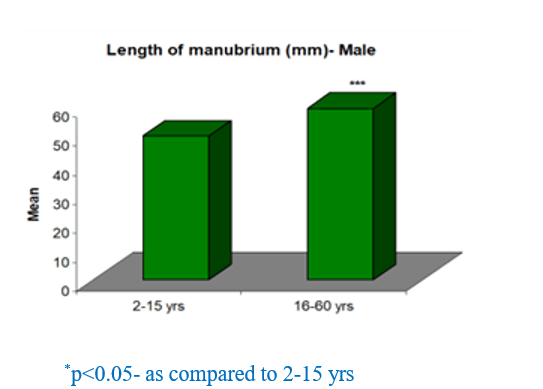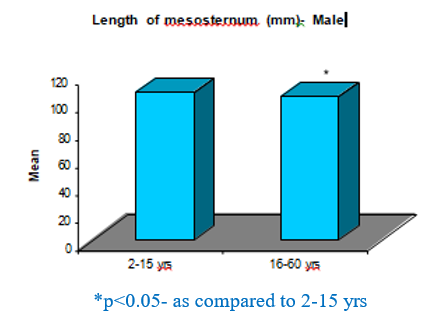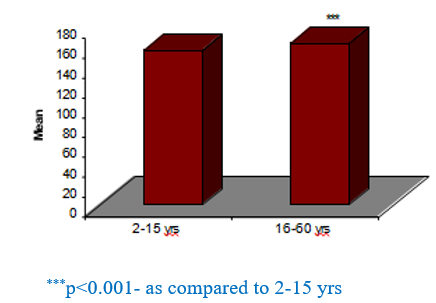Introduction
The assessment of age and sex between living male children and adults through measurement of different segment of sternum bone in north population of India are very important for data and report for collection in the field of forensic investigation, which facilitate the identifying of sex and age in living male children and adults through measurement of different segment of sternum bone. Therefore ideal rule of identification of sex and age is a sever need in medico legal cases. Sternum is much more appropriate for detection of sex and age of human beings separately from racial characters. This study with related to sternum bone have been done in male individual at previous in European country and also done in different state of our country as well as India, like Maharashtra, Gujarat, but they not fully fulfilled. Thus on the basis of collected data and report it is concluded that there is very little research with comparative measurement of different segment of sternum bone in the people of peripheral region of Uttar Pradesh. The inner surface of the sternum is also the attachment of the sternopericardial ligaments .1 The ratio between manubrial and mesosternal lengths differs between the sexes. [Wenzel J et al., 1789]. 2 Was the first to study the sternum for sexual dimorphism 3 extensively presented that the sternum is an index of age, sex and height of an individual and its measurements have an influence on the sex and age of that individual in European and African population. 4 Suggested that the male sternum is considerably longer than Studying its various morphometric measurements in various populations.In India, various researchers have presented their work on the sternum regarding sex determination.5, 6 Identification is recognition of an individual by means of various physical features and biological parameters, which are unique to each individual. Since the bone resists putrefaction and destruction by animals, they can be used for identification and can lead to a reliable determination of age, sex, race stature of the individual.
But when these bones are missing, recent findings have suggested that sternum and manubrium can act as valuable specimens 7, 8, 9, 10, 11, 12, 13. The total length of sternum is approximately 17 cm in males and less in females. The ratio between manubrial and mesosternal lengths differs between the sexes.14
Both the quantitative and qualitative human skeletal features have been explored for estimating sex of an individual. Whereas, the non-metric methods are simple, quick and easy to apply,.15 though they are more subjective in nature with higher inter-observer errors, thus not considered suitable for forensic applications.
With the introduction of discriminant function the female sternum. He also confirmed that the combined length of manubrium and mesosternum, and the total sternal length provide useful guide to the height of an individual. Similarly, 16 studied the sex differentiation in human sternum by analysis in forensic osteological studies, the subjectivity levels and the expertise needed has been reduced substantially17 and even 100% sexing accuracy can be obtained from it.
Materials and Methods
This study has been conducted on the total 100 subjects, 50 male (02-15 yrs) and 50 adult male (16-60yrs) of healthy people (living children & male adults) from general population of north India as well as in and around the Lucknow of Uttar Pradesh. After obtaining ethical clearance and informed consent form, the living subjects have been recruited from the healthy staff members of OPD, department of medicine, pediatrics and Obstetrics & gynecology at King George’s Medical University, U P, Lucknow. All the living subjects have been well informed about the nature of study. To prevent discrimination, living subjects have recruited for our study fulfilling inclusion criteria (male, age 16 to 60 years, BMI less than 25 and no history of chronic disease, at least 1 year tenure, no use of medication other than analgesics during the month preceding data collection). The living subjects have been explained the procedure of study. For the morphometry of the sternum, following measurements have been taken in to consideration.
Length of manubrium: It has been measured from the center of suprasternal notch to the centre of the manubrio-sternal junction in mid sagittal plane.
Length of mesosternum
It has been measured from the centre of manubrio- sternal junction to the centre of sterno-xiphoid junction in the mid sagittal plane.
Total length of sternum
It has been measured from the centre of jugular notch to xiphoid process in the mid sagittal plane.The above mentioned measurements have been further use to calculate various sternal size and indices according to the technique described by Ashley. Each linear measurement has been taken thrice on the anatomical position of the sternum using Mitutoyo-digital vernier calipers to the nearest millimeter with precision of 0.01 mm, according to definitions presented in and their average was recorded [Ashley GT-1956b]. 3
Results
Basic characteristics: The primary outcome measures of the study were in millimeter (mm). Besides that actual age (yrs), height (cm), weight (kg), chest circumference (cm), waist circumference and hip circumference (cm) were also noted.
Comparison
Male- 2 to 15 yrs vs. 16 to 60 yrs:
The comparison of mean length of manubrium, mesosternum and sternum between 2 to 15 yrs and 16 - 60 yrs males is summarized in Table 3 and also depicted in figure.1, 2, and 3respectively. Comparing the mean length, Student’s t test showed significantly different and higher length of manubrium (16.1%) (49.45 ± 3.45 vs. 58.97 ± 6.68, t=8.94, p<0.001) and length of sternum (4.0%) (156.16 ± 5.26 vs. 162.70 ± 5.70, t=5.97, p<0.001) in 16-60 yrs as compared to 2-15 yrs. In contrast, mean length of mesosternum lower (2.8%). significantly in 16-60 yrs as compared to 2-15 yrs (106.71 ± 6.25 vs. 103.74 ± 8.42, t=2.00, p=0.048). Comparison of length of different segment of sternum between 2 to 15 yrs male children and To 60 yrs males adult
Table 1
Table 1: Basic characteristics of 2-15 yrs male children
Table 2
Basic characteristics of 16-60 yrs male adults
3:
Table 3
Comparison of length of manubrium, mesosternum and sternum
Discussion
The study was conducted on 100 subjects (50 male living children and 50 male adults). Anthropometric and morphometric parameters were measured for forensic purposes in all subjects and correlated age, sex with their different part of sternum. Results from our study revealed that body weight, BMI, and abdominal circumference were in normal range. The finding suggests that osteometric evaluation of the sternum can be an effective method for identification of sex and age in the Lucknow population. Comparing the mean length, Student’s t test showed significantly different and higher (16.1%) length of manubrium in 16-60 yrs male living adults as compared to 2-15 yrs male living children(49.45 ± 3.45 vs. 58.97 ± 6.68, t=8.94, p<0.001).
On the basis of observation and result in my present study it was fully supported and agree of the previous researchers, who has done the work in measurement of sternum bone in cadaver and skeletal of human, because they told that the sterna has distinguish in different zone of India, as well as it is shorter than European country. The length of manubrium in adult was higher than children because the growth of sternum segment was Completely develop in adult, but the development in male children is continuous in ratio of male adults. It indicates that ratio between the male children and male adult was fully supported to the previous research rule.
However, mean length of sternum differ between the two groups living male children and living male adult (4.0%) (156.16 ± 5.26 vs. 162.70 ± 5.70,
t=5.97, p<0.001) though it higher4.0% in 16-60 yrs as compared to 2-15 yrs. This result and observation show that there was no eject explanation about segment of sternum and age, sex of male living adults male living children respectively.
According to observation and result we can discuss that previous study which was done by [Ashley GT et al., 1956b].3 [Queiroz A et al., 2004].[21] which agreed with our findings for assess the relationship in stage of development and sex between living male children and adult through measurement of sternum bone in lucknow city of U.P. and therefore further need for future study related to sternum.
Conclusion
The assessment of the relationship in stage of development and sex between living male children and adult through measurement of sternum bone in lucknow city of U.P., significantly different and higher length of sternum, because the growth of sternum segment was completely develop in adult, but the development in children male is continuous in ratio of adults male. It indicates that ratio between the children and adult male was fully supported to the previous research rule. But Therefore further need for future study related to sternum.
Statistical analysis
Data were summarized as Mean ± SD (standard deviation), range (min to max) and median. Groups were compared by independent Student’s t test. Pearson correlation was done to assess association between variables. A two-tailed (α=2) p<0.05 was considered statistically significant. Analyses were performed on SPSS software (windows version 21.0). The statistical analysis has been done by Dr Negi, from Central Drug Research Institute (CDRI Lucknow
Acknowledgement
The authors are grateful to all subjects who participated in this study. I would like to thanks Dr. M.P. Negi, Statistician in Central Drugs Research Institute (CDRI), Lucknow for his Statistical analysis and cooperation, and I would like to give specially Thanks Dr. Vimal Modi, Proffessor & Head, Department of Anatomy, Index
medical college, hospital & Research Centre, Malwanchal University Indore and Dr. Navneet kumar, Professor & Head, department of Anatomy, King George’s Medical University, U.P., Lucknow for developing this hypothesis, cooperation, and conducting this research work.




